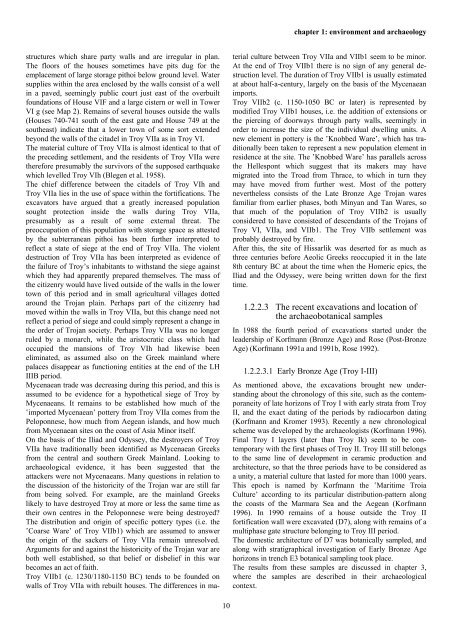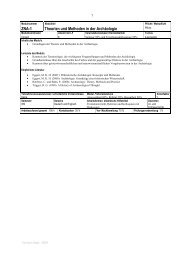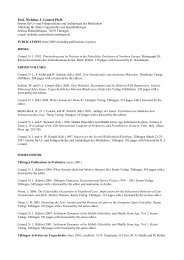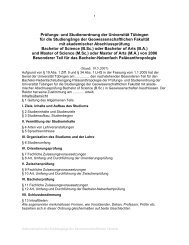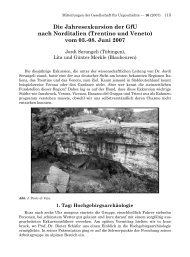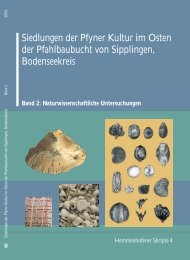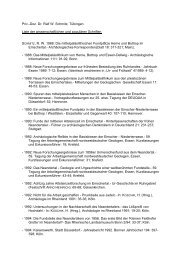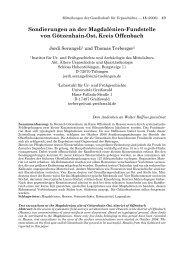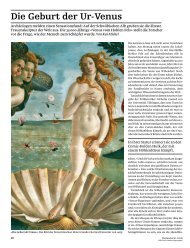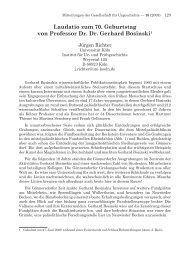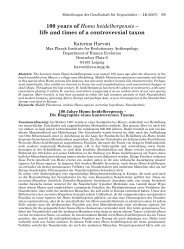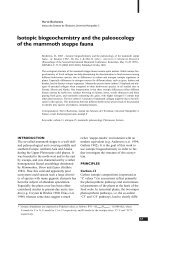bronze age environment and economy in the troad - Universität ...
bronze age environment and economy in the troad - Universität ...
bronze age environment and economy in the troad - Universität ...
You also want an ePaper? Increase the reach of your titles
YUMPU automatically turns print PDFs into web optimized ePapers that Google loves.
chapter 1: <strong>environment</strong> <strong>and</strong> archaeology<br />
structures which share party walls <strong>and</strong> are irregular <strong>in</strong> plan.<br />
The floors of <strong>the</strong> houses sometimes have pits dug for <strong>the</strong><br />
emplacement of large stor<strong>age</strong> pithoi below ground level. Water<br />
supplies with<strong>in</strong> <strong>the</strong> area enclosed by <strong>the</strong> walls consist of a well<br />
<strong>in</strong> a paved, seem<strong>in</strong>gly public court just east of <strong>the</strong> overbuilt<br />
foundations of House VIF <strong>and</strong> a large cistern or well <strong>in</strong> Tower<br />
VI g (see Map 2). Rema<strong>in</strong>s of several houses outside <strong>the</strong> walls<br />
(Houses 740-741 south of <strong>the</strong> east gate <strong>and</strong> House 749 at <strong>the</strong><br />
sou<strong>the</strong>ast) <strong>in</strong>dicate that a lower town of some sort extended<br />
beyond <strong>the</strong> walls of <strong>the</strong> citadel <strong>in</strong> Troy VIIa as <strong>in</strong> Troy VI.<br />
The material culture of Troy VIIa is almost identical to that of<br />
<strong>the</strong> preced<strong>in</strong>g settlement, <strong>and</strong> <strong>the</strong> residents of Troy VIIa were<br />
<strong>the</strong>refore presumably <strong>the</strong> survivors of <strong>the</strong> supposed earthquake<br />
which levelled Troy VIh (Blegen et al. 1958).<br />
The chief difference between <strong>the</strong> citadels of Troy VIh <strong>and</strong><br />
Troy VIIa lies <strong>in</strong> <strong>the</strong> use of space with<strong>in</strong> <strong>the</strong> fortifications. The<br />
excavators have argued that a greatly <strong>in</strong>creased population<br />
sought protection <strong>in</strong>side <strong>the</strong> walls dur<strong>in</strong>g Troy VIIa,<br />
presumably as a result of some external threat. The<br />
preoccupation of this population with stor<strong>age</strong> space as attested<br />
by <strong>the</strong> subterranean pithoi has been fur<strong>the</strong>r <strong>in</strong>terpreted to<br />
reflect a state of siege at <strong>the</strong> end of Troy VIIa. The violent<br />
destruction of Troy VIIa has been <strong>in</strong>terpreted as evidence of<br />
<strong>the</strong> failure of Troy’s <strong>in</strong>habitants to withst<strong>and</strong> <strong>the</strong> siege aga<strong>in</strong>st<br />
which <strong>the</strong>y had apparently prepared <strong>the</strong>mselves. The mass of<br />
<strong>the</strong> citizenry would have lived outside of <strong>the</strong> walls <strong>in</strong> <strong>the</strong> lower<br />
town of this period <strong>and</strong> <strong>in</strong> small agricultural vill<strong>age</strong>s dotted<br />
around <strong>the</strong> Trojan pla<strong>in</strong>. Perhaps part of <strong>the</strong> citizenry had<br />
moved with<strong>in</strong> <strong>the</strong> walls <strong>in</strong> Troy VIIa, but this change need not<br />
reflect a period of siege <strong>and</strong> could simply represent a change <strong>in</strong><br />
<strong>the</strong> order of Trojan society. Perhaps Troy VIIa was no longer<br />
ruled by a monarch, while <strong>the</strong> aristocratic class which had<br />
occupied <strong>the</strong> mansions of Troy VIh had likewise been<br />
elim<strong>in</strong>ated, as assumed also on <strong>the</strong> Greek ma<strong>in</strong>l<strong>and</strong> where<br />
palaces disappear as function<strong>in</strong>g entities at <strong>the</strong> end of <strong>the</strong> LH<br />
IIIB period.<br />
Mycenaean trade was decreas<strong>in</strong>g dur<strong>in</strong>g this period, <strong>and</strong> this is<br />
assumed to be evidence for a hypo<strong>the</strong>tical siege of Troy by<br />
Mycenaeans. It rema<strong>in</strong>s to be established how much of <strong>the</strong><br />
‛imported Mycenaean’ pottery from Troy VIIa comes from <strong>the</strong><br />
Peloponnese, how much from Aegean isl<strong>and</strong>s, <strong>and</strong> how much<br />
from Mycenaean sites on <strong>the</strong> coast of Asia M<strong>in</strong>or itself.<br />
On <strong>the</strong> basis of <strong>the</strong> Iliad <strong>and</strong> Odyssey, <strong>the</strong> destroyers of Troy<br />
VIIa have traditionally been identified as Mycenaean Greeks<br />
from <strong>the</strong> central <strong>and</strong> sou<strong>the</strong>rn Greek Ma<strong>in</strong>l<strong>and</strong>. Look<strong>in</strong>g to<br />
archaeological evidence, it has been suggested that <strong>the</strong><br />
attackers were not Mycenaeans. Many questions <strong>in</strong> relation to<br />
<strong>the</strong> discussion of <strong>the</strong> historicity of <strong>the</strong> Trojan war are still far<br />
from be<strong>in</strong>g solved. For example, are <strong>the</strong> ma<strong>in</strong>l<strong>and</strong> Greeks<br />
likely to have destroyed Troy at more or less <strong>the</strong> same time as<br />
<strong>the</strong>ir own centres <strong>in</strong> <strong>the</strong> Peloponnese were be<strong>in</strong>g destroyed<br />
The distribution <strong>and</strong> orig<strong>in</strong> of specific pottery types (i.e. <strong>the</strong><br />
‛Coarse Ware’ of Troy VIIb1) which are assumed to answer<br />
<strong>the</strong> orig<strong>in</strong> of <strong>the</strong> sackers of Troy VIIa rema<strong>in</strong> unresolved.<br />
Arguments for <strong>and</strong> aga<strong>in</strong>st <strong>the</strong> historicity of <strong>the</strong> Trojan war are<br />
both well established, so that belief or disbelief <strong>in</strong> this war<br />
becomes an act of faith.<br />
Troy VIIb1 (c. 1230/1180-1150 BC) tends to be founded on<br />
walls of Troy VIIa with rebuilt houses. The differences <strong>in</strong> material<br />
culture between Troy VIIa <strong>and</strong> VIIb1 seem to be m<strong>in</strong>or.<br />
At <strong>the</strong> end of Troy VIIb1 <strong>the</strong>re is no sign of any general destruction<br />
level. The duration of Troy VIIb1 is usually estimated<br />
at about half-a-century, largely on <strong>the</strong> basis of <strong>the</strong> Mycenaean<br />
imports.<br />
Troy VIIb2 (c. 1150-1050 BC or later) is represented by<br />
modified Troy VIIb1 houses, i.e. <strong>the</strong> addition of extensions or<br />
<strong>the</strong> pierc<strong>in</strong>g of doorways through party walls, seem<strong>in</strong>gly <strong>in</strong><br />
order to <strong>in</strong>crease <strong>the</strong> size of <strong>the</strong> <strong>in</strong>dividual dwell<strong>in</strong>g units. A<br />
new element <strong>in</strong> pottery is <strong>the</strong> ‛Knobbed Ware’, which has traditionally<br />
been taken to represent a new population element <strong>in</strong><br />
residence at <strong>the</strong> site. The ‛Knobbed Ware’ has parallels across<br />
<strong>the</strong> Hellespont which suggest that its makers may have<br />
migrated <strong>in</strong>to <strong>the</strong> Troad from Thrace, to which <strong>in</strong> turn <strong>the</strong>y<br />
may have moved from fur<strong>the</strong>r west. Most of <strong>the</strong> pottery<br />
never<strong>the</strong>less consists of <strong>the</strong> Late Bronze Age Trojan wares<br />
familiar from earlier phases, both M<strong>in</strong>yan <strong>and</strong> Tan Wares, so<br />
that much of <strong>the</strong> population of Troy VIIb2 is usually<br />
considered to have consisted of descendants of <strong>the</strong> Trojans of<br />
Troy VI, VIIa, <strong>and</strong> VIIb1. The Troy VIIb settlement was<br />
probably destroyed by fire.<br />
After this, <strong>the</strong> site of Hissarlik was deserted for as much as<br />
three centuries before Aeolic Greeks reoccupied it <strong>in</strong> <strong>the</strong> late<br />
8th century BC at about <strong>the</strong> time when <strong>the</strong> Homeric epics, <strong>the</strong><br />
Iliad <strong>and</strong> <strong>the</strong> Odyssey, were be<strong>in</strong>g written down for <strong>the</strong> first<br />
time.<br />
1.2.2.3 The recent excavations <strong>and</strong> location of<br />
<strong>the</strong> archaeobotanical samples<br />
In 1988 <strong>the</strong> fourth period of excavations started under <strong>the</strong><br />
leadership of Korfmann (Bronze Age) <strong>and</strong> Rose (Post-Bronze<br />
Age) (Korfmann 1991a <strong>and</strong> 1991b, Rose 1992).<br />
1.2.2.3.1 Early Bronze Age (Troy I-III)<br />
As mentioned above, <strong>the</strong> excavations brought new underst<strong>and</strong><strong>in</strong>g<br />
about <strong>the</strong> chronology of this site, such as <strong>the</strong> contemporaneity<br />
of late horizons of Troy I with early strata from Troy<br />
II, <strong>and</strong> <strong>the</strong> exact dat<strong>in</strong>g of <strong>the</strong> periods by radiocarbon dat<strong>in</strong>g<br />
(Korfmann <strong>and</strong> Kromer 1993). Recently a new chronological<br />
scheme was developed by <strong>the</strong> archaeologists (Korfmann 1996).<br />
F<strong>in</strong>al Troy I layers (later than Troy Ik) seem to be contemporary<br />
with <strong>the</strong> first phases of Troy II. Troy III still belongs<br />
to <strong>the</strong> same l<strong>in</strong>e of development <strong>in</strong> ceramic production <strong>and</strong><br />
architecture, so that <strong>the</strong> three periods have to be considered as<br />
a unity, a material culture that lasted for more than 1000 years.<br />
This epoch is named by Korfmann <strong>the</strong> ‛Maritime Troia<br />
Culture’ accord<strong>in</strong>g to its particular distribution-pattern along<br />
<strong>the</strong> coasts of <strong>the</strong> Marmara Sea <strong>and</strong> <strong>the</strong> Aegean (Korfmann<br />
1996). In 1990 rema<strong>in</strong>s of a house outside <strong>the</strong> Troy II<br />
fortification wall were excavated (D7), along with rema<strong>in</strong>s of a<br />
multiphase gate structure belong<strong>in</strong>g to Troy III period.<br />
The domestic architecture of D7 was botanically sampled, <strong>and</strong><br />
along with stratigraphical <strong>in</strong>vestigation of Early Bronze Age<br />
horizons <strong>in</strong> trench E3 botanical sampl<strong>in</strong>g took place.<br />
The results from <strong>the</strong>se samples are discussed <strong>in</strong> chapter 3,<br />
where <strong>the</strong> samples are described <strong>in</strong> <strong>the</strong>ir archaeological<br />
context.<br />
10


